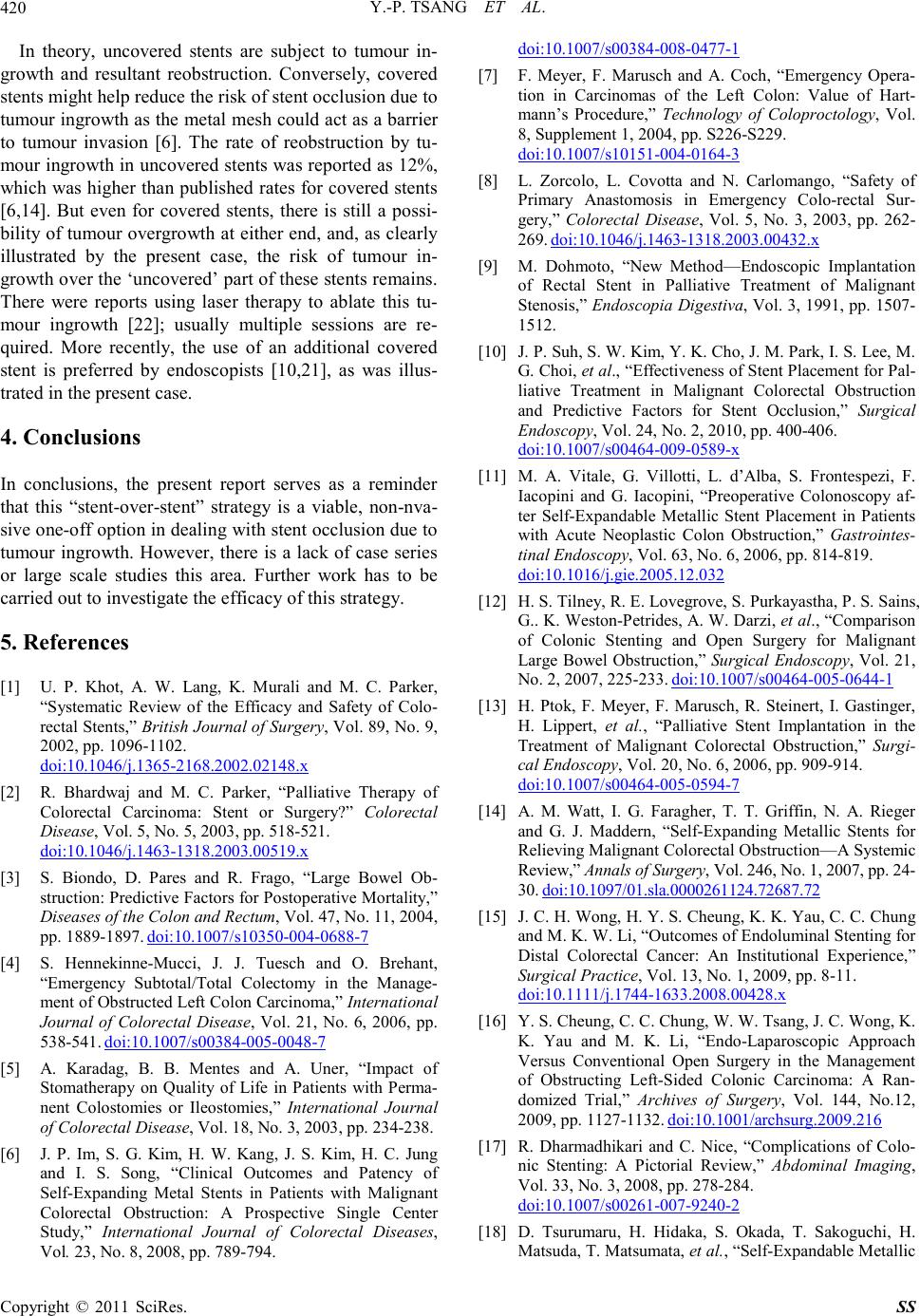
Y. -P. TSANG ET AL.
420
stents are subject to tumour in-
gr
. Conclusions
conclusions, the present report serves as a reminder
. References
] U. P. Khot, A. W. Lang, K. Murali and M. C. Parker,
2002.02148.x
In theory, uncovered
owth and resultant reobstruction. Conversely, covered
stents might help reduce the risk of stent occlusion due to
tumour ingrowth as the metal mesh could act as a b arrier
to tumour invasion [6]. The rate of reobstruction by tu-
mour ingrowth in uncovered stents was reported as 12%,
which was higher than published rates for covered stents
[6,14]. But even for covered stents, there is still a possi-
bility of tumour overgrowth at either end, and, as clearly
illustrated by the present case, the risk of tumour in-
growth over the ‘uncovered’ part of these stents remains.
There were reports using laser therapy to ablate this tu-
mour ingrowth [22]; usually multiple sessions are re-
quired. More recently, the use of an additional covered
stent is preferred by endoscopists [10,21], as was illus-
trated in the present case.
4
In
that this “stent-over-stent” strategy is a viable, non-nva-
sive o ne-o ff o pti on in d eal in g with stent occlusion due to
tumour ingrowth. However, there is a lack of case series
or large scale studies this area. Further work has to be
carried out to investigate the efficacy of this strategy.
5
[1 “Systematic Review of the Efficacy and Safety of Colo-
rectal Sten ts,” British Journal of Surgery, Vol. 89, No. 9,
2002, pp. 1096-110 2.
doi:10.1046/j.1365-2168.
ative Therapy of[2] R. Bhardwaj and M. C. Parker, “Palli
Colorectal Carcinoma: Stent or Surgery?” Colorectal
Disease, Vol. 5, No. 5, 2003, pp. 518-521.
doi:10.1046/j.1463-1318.2003.00519.x
[3] S. Biondo, D. Pares and R. Frago, “Large Bowel Ob-
struction : Predi ctive Factors for P ostop erative Mort ality,”
Diseases of the Colon and Rectum, Vol. 47, No. 11, 2004,
pp. 1889 -1897. doi:10.1007/s10350-004-0688-7
[4] S. Hennekinne-Mucci, J. J. Tuesch and O. Brehant,
“Emergency Subtotal/Total Colectomy in the Manage-
ment of Obstructed Left Colon Carcinoma,” International
Journal of Colorectal Disease, Vol. 21, No. 6, 2006, pp.
538-541. doi:10.1007/s00384 -005-0048-7
[5] A. Karadag, B. B. Mentes and A. Uner, “Impact
Vol. 23, No. 8, 20 08 , pp. 78 9- 7 94 .
of
Stomatherapy on Quality of Life in Patients with Perma-
nent Colostomies or Ileostomies,” International Journal
of Colorectal Disease, Vol. 18, No. 3, 2003, pp. 234-238.
[6] J. P. Im, S. G. Kim, H. W. Kang, J. S. Kim, H. C. Jung
and I. S. Song, “Clinical Outcomes and Patency of
Self-Expanding Metal Stents in Patients with Malignant
Colorectal Obstruction: A Prospective Single Center
Study,” International Journal of Colorectal Diseases,
do i:10.1007/s00384-008-0477-1
[7] F. Meyer, F. Marusch and A. Coch,
tion in Carcinomas of the Left Col
“Emergency Opera-
on: Value of Hart-
mann’s Procedure,” Technology of Coloproctology, Vol.
8, Supplement 1, 2004, pp. S226-S229.
do i:10.1007/s10151-004-0164-3
[8] L. Zorcolo, L. Covotta and N. Carloma
Primary Anastomosis in Emergenngo, “Safety of
cy Colo-rectal Sur-
gery,” Colorectal Disease, Vol. 5, No. 3, 2003, pp. 262-
269. doi:10.1046/j.1463-1318.2003.00432.x
[9] M. Dohmoto, “New Method—Endoscopic Implantation
of Rectal Stent in Palliative Treatment of Malignant
i, et al., “Effectiveness o f Stent Placement for Pal-
Stenosis,” Endoscopia Digestiva, Vol . 3, 199 1, pp. 1507-
1512.
[10] J. P. Suh, S. W. Kim, Y. K. Cho, J. M. Park, I. S. Lee, M.
G. Cho
liative Treatment in Malignant Colorectal Obstruction
and Predictive Factors for Stent Occlusion,” Surgical
Endoscopy, Vol. 24, No. 2, 201 0, pp. 40 0-406.
do i:10.1007/s00464-009-0589-x
[11] M. A. Vitale, G. Villotti, L. d’Alba, S. Fronte
Iacopini and G. Iacopini, “Preopspezi, F.
erative Colonoscopy af-
ter Self-Expandable Metallic Stent Placement in Patients
with Acute Neoplastic Colon Obstruction,” Gastrointes-
tinal Endoscopy, Vol. 63, No. 6, 200 6, pp . 814-819.
do i:10.1016/ j.gie.2005.12.0 32
[12] H. S. Tilney, R. E. Lovegrove, S. Purkayastha, P. S. S
G.. K. Weston-Petrides, A. W. Dains,
arzi, et al., “Comparison
of Colonic Stenting and Open Surgery for Malignant
Large Bowel Obstruction,” Surgical Endoscopy, Vol. 21,
No. 2, 2007, 225-233. doi:10.1007/s00464-005-0644-1
[13] H. Ptok, F. Meyer, F. Marusch, R. Steinert, I. Gastinger,
H. Lippert, et al., “Palliative Stent Implantation in the
Treatment of Malignant Colorectal Obstruction,” Surgi -
cal Endoscopy, Vo l. 20, N o. 6, 20 06, pp . 909-914.
do i:10.1007/s00464-005-0594-7
[14] A. M. Watt, I. G. Faragher, T. T. Griffin, N. A. R
and G. J. Maddern, “Self-Expandieger
ing Metallic Stents for
Relieving Malignant Colorectal Obstruction—A Systemic
Review,” Annals of Surgery, Vol. 246, No. 1, 2007, pp. 24-
30. doi:10.1097/01.sla.0000261124.72687.72
[15] J. C. H. Wong, H. Y. S. Cheung, K. K. Yau, C. C. Chun g
and M. K. W. Li, “Outcomes of Endoluminal Stenting for
Distal Colorectal Cancer: An Institutional Experience,”
Surgical Practice, Vol. 13, No. 1, 2009, pp. 8-11.
doi:10.1111/j.1744-1633.2008.00428.x
[16] Y. S. Cheung, C. C. Chung, W. W. Tsang, J. C. Wong
K. Yau and M. K. Li, “Endo-Laparo, K.
scopic Approach
Versus Conventional Open Surgery in the Management
of Obstructing Left-Sided Colonic Carcinoma: A Ran-
domized Trial,” Archives of Surgery, Vol. 144, No.12,
2009, pp. 1127-113 2. doi :10.10 01/archsurg.2009.2 16
[17] R. Dharmadhikari and C. Nice, “Complications of Colo-
nic Stenting: A Pictorial Review,” Abdominal Imaging,
Vol. 33, No. 3, 2008, pp. 278-284.
do i:10.1007/s00261-007-9240-2
[18] D. Tsurumaru, H. Hidaka, S. Okad
Matsuda, T. Matsumata, et al. , “Sa, T. Sakoguchi, H.
elf-Expandable Metallic
Copyright © 2011 SciRes. SS